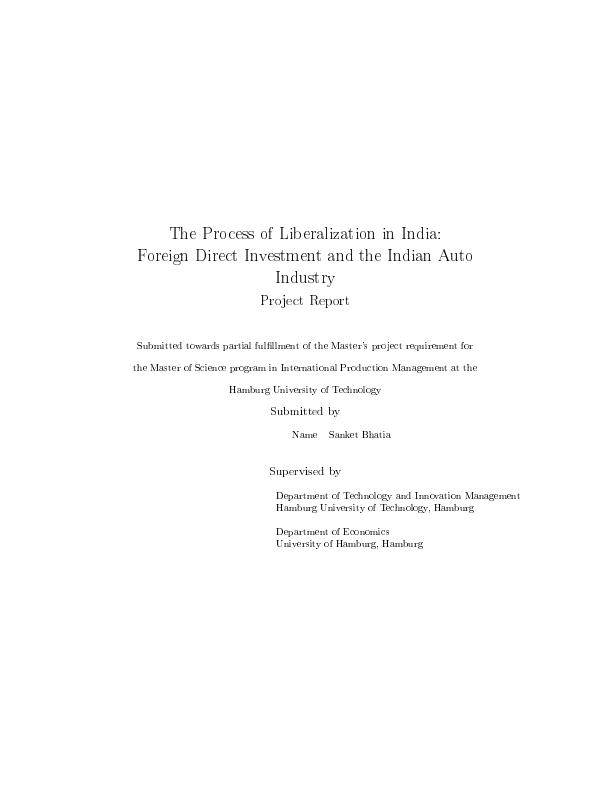Excerpt
The Process of Liberalization in India:
Foreign Direct Investment and the Indian Auto Industry
India, the second most populous country in the world, and the largest democracy, evokes images of teeming populations, widespread poverty and, more recently, of software technology and call centers. It has often been claimed that everything that can be said about India is true. India is a vast country with rampant problems of poverty, inequality, illiteracy and poor health care, ranking very low on the Human Development Index Scale (see Fig. [Country Profile India]). At the same time, Indian industry has picked up in the last decade to make India the third largest economy (Footnote: expected ranking 2005-06 in the world, in GDP (Purchasing Power Parity) terms, after the U.S.A. and China). Today the Indian economy is a fourth of the US economy, and half of China´s. But current GDP growth rates, one of the highest in the world for India, suggest an upward trend.
<Graphics file: country profile india, population, economic, health, source UN.bmp>
<Country Profile India>Country Profile India Source: UNO
This increase in GDP has been contributed mainly by the industrial and service sectors, with the service sector playing an increasingly important role. India´s almost stagnant agricultural sector, even today one of the most underdeveloped in the world, still constitutes around a quarter of national GDP, much above the world average (see Fig. [Country Profile India]). It is widely believed that the current strength of industry in India has followed liberalization reforms that took place in the early 1990´s (see Section [sec:Economic-Reforms:-An]). Since then, India´s trade has boomed and there has been sustained investment into industry by foreign players, bringing in not only foreign capital, but also international technology and know-how. There have also been indirect consequences of development, employment, efficiency and rising per capita incomes.
The economic reforms of the the 1990's have changed the face of the Indian economy. They have made available to Indian consumers, at increasingly affordable prices, offerings that were never before available. While making India more attractive for foreign investors, the reforms have also helped integrate the Indian economy with the global economy, enabling Indian companies and labor to seek avenues abroad.
An increasing level of foreign investment reflects international confidence in the Indian market, leads to better infrastructure, creates jobs, increases the level of sophistication of the local demand, and strengthens Indian companies by exposing them to international competition. Foreign investment and GDP growth can often have a bi-directional causal relationship[key-18]. Foreign investment in a sustainable way can thus lead to a better standard of living for a developing country like India.
The role of the government in the process of economic reforms cannot be overemphasized. Since the reform process is in the end driven by the government, though it is certainly initiated, accelarated or slowed down by various groups, it would be possible to conjecture the role that the government has played in improving overall industry and public welfare through market reforms. It may also be possible to guess possible new roles of the government in the post-reform era (Footnote: I hardly suggest that the era of reforms is over, or that the reforms so far are sufficient. But only that the process has made a beginning, to allow the Indian economy to achieve greater heights.)
As the direct and indirect effects of liberalization in general, and FDI in particular can be seen, certain social tasks that need to be tackled also present themselves. The most important of these tasks are the decrease in the level of poverty, and to reduce the gap between "the two Indias": the rich, affluent, and upwardly mobile urban India, and the rural India, which still dwells in poverty levels of a century before. Reforming the agricultural sector should be, and is, one of the foremost priorities of policy makers, the sector affecting directly the plight of rural India.
[...]
- Quote paper
- Master of Science and MBA Sanket Bhatia (Author), 2005, The process of liberalization in India: Foreign direct investment and the Indian auto industry, Munich, GRIN Verlag, https://www.grin.com/document/60790
Publish now - it's free























Comments